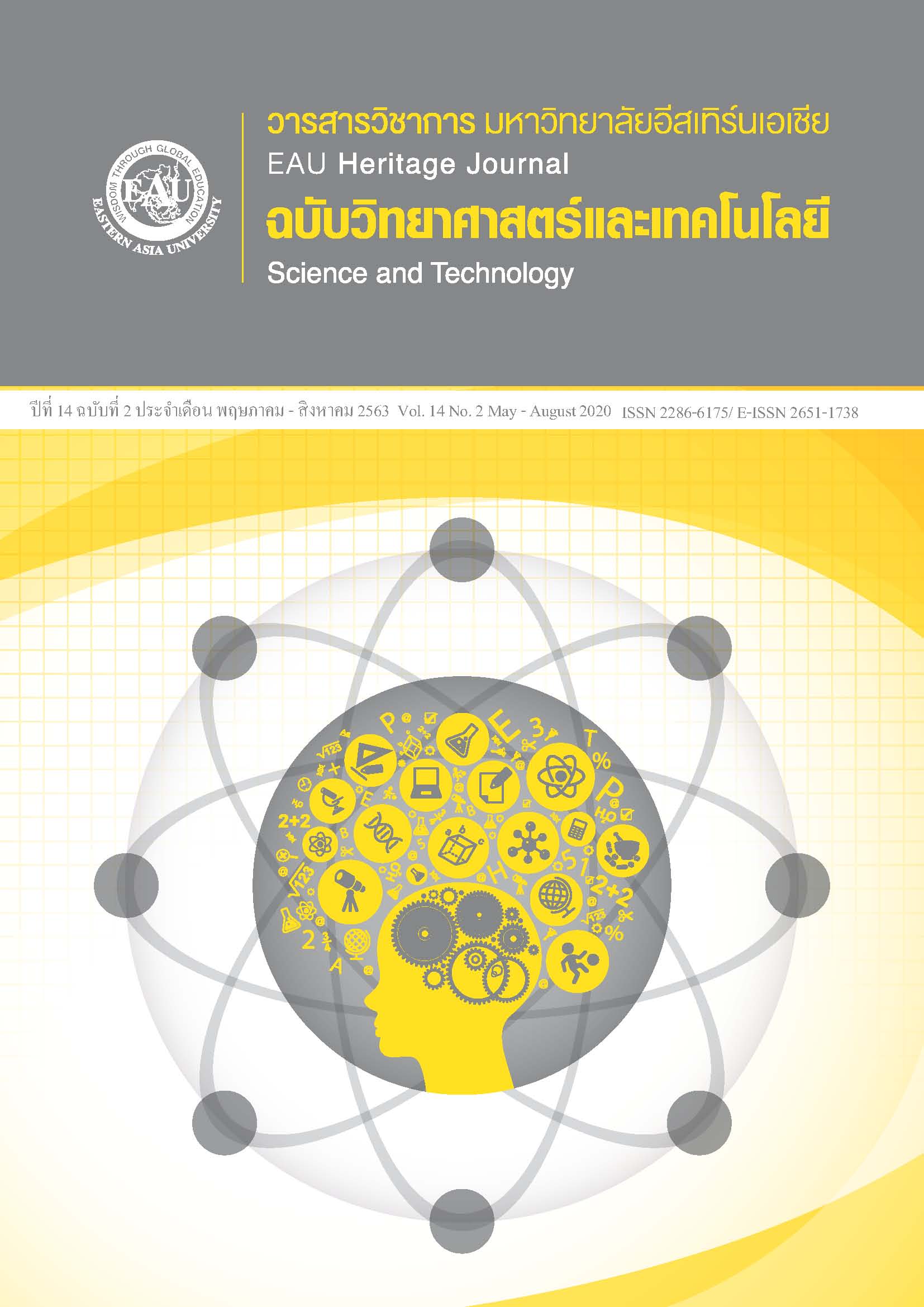การคัดเลือกเชื้อจุลินทรีย์ปฏิปักษ์จากใบพืชที่มีฤทธิ์ยับยั้งเชื้อก่อโรคเหี่ยวของพริก
คำสำคัญ:
ใบพืช, พริก, ราปฏิปักษ์, โรคเหี่ยวฟิวซาเรียมบทคัดย่อ
งานวิจัยนี้มีวัตถุประสงค์เพื่อคัดแยกเชื้อราจากใบพืชผักสมุนไพรชนิดต่าง ๆ และเพื่อทดสอบประสิทธิภาพของเชื้อราจากใบพืชที่แยกได้ในการเป็นปฏิปักษ์ต่อเชื้อราก่อโรคในพริก โดยทำการแยกเชื้อรา 16 ไอโซเลตได้จากพืช 6 ชนิดได้แก่ กระเพรา สะระแหน่ มะละกอ ตะไคร้ มิ้นท์ และแมงลัก เมื่อนำมาทดสอบการเป็นปฏิปักษ์ต่อเชื้อ Fusarium sp. ที่ก่อโรคเหี่ยวในพริก พบว่าเชื้อรารหัส SB5 สามารถยับยั้งการเจริญเติบโตของเชื้อโรคได้มากที่สุด คือ 83.00% รองลงมาคือเชื้อรารหัส B1 ยับยั้งเชื้อโรคได้ 75.60% ซึ่งเชื้อราทั้ง 2 ไอโซเลตนี้มีประสิทธิภาพสูงกว่าเชื้อราอื่นที่เหลืออย่างมีนัยสำคัญทางสถิติ เมื่อวิเคราะห์ระดับชีวโมเลกุลพบว่า เชื้อรารหัส SB5 คือเชื้อ Aspergillus flavus และเชื้อรารหัส B1 คือเชื้อ Penicillium oxalicum
เอกสารอ้างอิง
Announcement of the Ministry of Public Health on foods that have toxic residues, 2017” (2017, 18 September). Government Gazette, 134(Special issue 228), 8-33. (in Thai)
Bashir, R. M., Atiq, M., Sahi, T. S., Mohyo-ud-Din, A., Mohsan, Abbas, W., Iqbal, M., Raheel, M., & Khan, Q. A. T. (2016). In-vitro antagonistic potential of different fungi against Fusarium oxysporum f. sp. capsici. International Journal of Sciences: Basic and Applied Research, 29(2), 248-257.
Bovichian, R. (2018). Agricultural economic data. Retrieved from http://www.oae.go.th/. (in Thai)
Bunlangswan, N. (2010). Prevention of Alternaria Leaf Spot and Fusarium wilt diseases in chili and tomato using Endophytic actinomycetes and Trichoderma harzianum (Master’s thesis). Chiang Mai University, Chiang Mai. (in Thai)
Cal, A. D., Sztejnberg, A., Sabuquillo, P., & Melgarejo, P. (2009). Management Fusarium wilt on melon and watermelon by Penicillium oxalicum. Biological Control, 551(3), 480-486.
Doyle, J.J., & Doyle, J.L. (1987). A rapid DNA Isolation procedure for small quantities of fresh leaf tissue. Phytochemical Bulletin, 19(1), 11-15.
FAO. (2016). Crop production data. Retrieved from http://www.fao.org/faostat/en/#data/QC.
Ferniah, R. S., Pujiyanto, S., & Kusumaningrum, H. P. (2018). Indonesian red chilli (Capsicum annuum L.) capsaicin and its correlation with their responses to Pathogenic Fusarium oxysporum. NICHE Journal of Tropical Biology, 1(2), 7-12.
Hamdi, N. B-M., Salem, I. B., & Hamdi, M. M. (2018). Evaluation of the efficiency of Trichoderma Penicillium, and Aspergillus species as Biological control agents against four soil-borne Fungi of melon and watermelon. Egyptian Journal of Biological Pest Control, 28(25), 1-12.
Jankura, E., & Lakatosava, J. (2014). Effect of Aspergillus spp. On Fusarium oxysporum pathogenic for grapevines. 37th World Congress of Vine and Wine, Mendoza, Argentina (pp. 1-2). Mendoza, Argentina: Ministry of Agriculture, Livestock and Fisheries of Argentina.
Khan, B., Akash, Z., Asad, S., Javed, N., Rajput, N. A., Jabbar, A., Din, W. U., & Atif, R. M. (2017). Antagonistic potential of Trichoderma harzianum against Fusarium oxysporum f. sp. cubense associated with Panama wilt of banana. Pakistan Journal of Phytopathology, 29(1), 111-116.
Murtaza, A., Bokhari, S. A. A., Kanwal, I., Ali, Y., Ahmad, T., Habib, A., Mazhar, K., Hussain, M., & Randhawa, S. (2017). Anti-fungal potential of Chilli Germplasm Agent Fusarium wilt. Pakistan Journal of Phytopathology, 29(01), 57-61.
Nagendran, K., Loganathan, M., Saha, S., Mishra, A., Pandey, K. K., Rai, R. M., Gupta, S., Rai, A. B., & Singh, B.(2016). Biological management of wilt disease on chilli caused by Fusarium solani. Vegetable Science, 43(2), 253-256.
Nareewuttikun, N. and Akarapisan, A. (2010). Evaluation of Bacterial Antagonistic efficiency for control of Sclerotium rolfsii and Fusarium oxysporum f. sp. lycopersici causing tomato soil borne diseases. Journal of Agriculture 26(special), 147-154. (in Thai)
Neela, F. A., Sonia, I. A., & Shamsi, S. (2014). Antifungal activity of selected medicinal plant extract on Fusarium oxysporum schlechtthe causal agent of Fusarium wilt disease in tomato. American Journal of Plant Sciences, 5(11), 2665-2671.
Pandita, D., Bhat, M. A, Mir, S., Jabeen, N., Anwar, A., Hussain, K., Dar, N. A., Dar, S. Q., & Wani, M. Y. (2019). Screening of traditional chilli cultivars of Kashmir for Fusarium wilt resistance. International Journal of Chemical Studies, 7(1), 1501-1503.
Prasannath, K., Karunakaran, S., & Mahendran, S. (2011). Control of Fusarium wilt of chilli (Capsicum annuum) by crude plant extracts. Proceedings of the 10th Annual Research Session-2011(pp. 291-294). Sri Lanka: Eastern University.
Ruangsanka, S. (2014). Identification of Phosphate-Solubilizing Fungi from the asparagus rhizosphere as antagonists of the root and crown rot pathogen Fusarium oxysporum. Science Asia, 40(1), 16-20.
Senadee, W., Pomlit, P., & Chaiyaporn, C. (2018). Turn the chili into a safe chili with the Chili Model. Agricultural Housing, 42(2), 63-87. (in Thai)
Tang-um, J. (2012). Anti-phytopathogenic fungal activity in tomatoes of Endophytic Streptomyces strain P4. (Master's thesis). Graduate School, Chiang Mai University, Chiang Mai. (in Thai)
Wani, S. A., Mohiddin, F. A., Hamid, B., Rizvi, G., Bhat, K. A., Hamid, A., Alam, A., Baba, Z. A., Padder, S. A., & Bhat, M. A. (2014). Incidence of Fusarium wilt of chilli (Capsicum annum L.) in Kashmir valley and its management by Trichoderma spp. Mycopathologia, 12(1), 1-8.
Yacharone, S. (2009). Screening of suitable Antagonist Microbes for Biological control of soil borne pathogens (Master’s thesis). Chiang Mai University, Chiang Mai. (in Thai)







